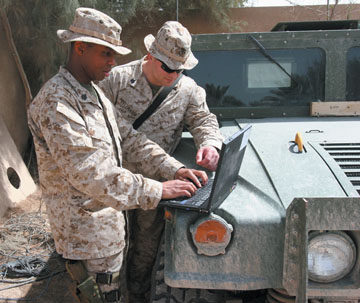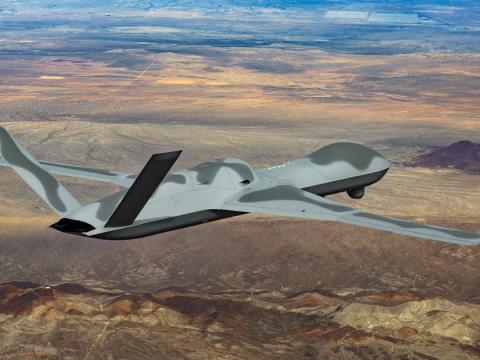Military Receives Outlines To Revamp Acquisition
 |
Staff Sgt. Alfred Hickman, USMC, and Sgt. Sandro Kitzmann, USMC, work on a computer at Camp Fallujah, Iraq. Reports by the Defense Science Board and legislation are helping the U.S. Defense Department improve the information technology acquisition process to field capabilities to troops more quickly. |
The U.S. Defense Department is taking significant strides toward resolving problems with information technology acquisition in part because of impetus from outside parties. Reports by an independent board and pending legislation have made specific recommendations for changes in the procurement process that the department is working to implement. The proposed alterations include testing a new process on 10 information technology programs as well as the need for officials to purchase the right items, select more effective leadership and take into account the quick pace of technology turnover. Many of the suggestions coincide with thoughts and efforts already underway in the department, but they offer framework for executing plans.
In March and April 2009, the Defense Science Board, at the request of the Defense Department, researched and published two reports titled “Department of Defense Policies and Procedures for the Acquisition of Information Technology” and “Creating a DOD Strategic Acquisition Platform.” The former examines challenges in the department’s information technology acquisition process, recommending the need for a new approach. It also calls for the clarification and strengthening of roles and responsibilities of leadership in the acquisition field as well as strengthening the acquisition work force.
According to the policies and procedures report, the secretary of defense should “recognize that the current acquisition process for information technology is ineffective. Delays and cost growth for acquisition of both major weapons systems and information management systems create an unacceptable risk to national security.” The proposed process would model commercial practices for rapid acquisition and continually upgrade and improve capabilities to deliver them in increments of 18 months or less.
In regard to personnel changes, the report suggests that the undersecretary of defense for acquisition, technology and logistics (USD AT&L) “work with service and agency acquisition executives to improve the capabilities and selection process for program executive officers and program managers.” It additionally calls for consolidation of “all acquisition oversight of information technology under the USD AT&L by moving into that organization those elements of the OASD (NII)/DOD CIO [Office of the Assistant Secretary of Defense for Networks and Information Integration/DOD Chief Information Officer] and Business Transformation Agency responsible for information technology acquisition oversight. The remainder of OASD (NII)/DOD CIO is retained as it exists today, but should be strengthened as indicated in the previous recommendation.” However, the realignment recommendation includes a footnote that says the task force involved with the report did not agree unanimously on the decision.
The report also touches on the education of officials in the acquisition field, saying, “The USD AT&L shall direct the
Creating a DOD Strategic Acquisition Platform makes further and stronger recommendations for the secretary of defense in regard to information technology acquisition and emphasizes the essential need for reform, asserting that “fixing the DOD acquisition process is a critical national security issue … DOD needs a strategic acquisition platform to guide the process of equipping its forces with the right materiel to support mission needs in an expeditious, cost-effective manner. The incoming leadership must address this concern among its top priorities, as the nation’s military prowess depends on it.”
This report states that threats will persist and budgets will decline, making it imperative for success that the Defense Department streamline its acquisitions. It makes four major suggestions for how to improve: buy the right things; select an effective leadership team with proven, relevant experience; reform and streamline the acquisition process; and improve acquisition execution. In the document, the writers explain that weapons systems acquisition processes are not responsive enough for information technology programs.
With information technology advancing one generation approximately every 18 months, current processes mean that once technology is fielded it already is out of date. Information technology also relies more heavily on the commercial sector than other areas of defense acquisition, requiring a different set of rules to make acquisition successful.
In addition, the report states that Congress can and must be part of the solution. People involved with the report testified before the House Armed Services Committee about the Defense Science Board’s findings as the committee worked on the National Defense Authorization Act for Fiscal Year 2010. As of September, that legislation includes a provision for the secretary of defense to try a new acquisition procedure on up to 10 information technology acquisition programs a year. The House committee envisions the military using the same procedure for each of the programs.
The idea behind the legislation was to give the Defense Department broad outlines in which it has the flexibility to shape the process to what it needs. If early attempts require tweaking, then legislators and officials can make changes. This action of trying new procedures is a pilot program intended to serve as a positive step toward change, but not necessarily a radical one. The alteration is in line with what the department wants to do and enables the military to codify the process.
-NOV09.jpg) |
Participants in the deployment phase of last year’s exercise Austere Challenge prepare to test computer networks and communications systems in the exercise command post at Grafenwoehr (Germany) Training Area. Under changes to the military’s information technology acquisition process, warfighters will receive capabilities sooner. |
The 10-program mandate allows the military to test the new process and examine its effectiveness by limiting it and reviewing it. If the process works successfully after a year or more, Congress could remove the number limit, but first the Defense Department has to prove the validity of its efforts. The legislation does not restrict the size of the programs chosen for the pilot study, and in fact legislators want an overarching process that encompasses large and small efforts.
Another assumption behind the legislation is that over time new information technology acquisition processes will result in reduced costs. If programs can be broken down into smaller pieces, legislators expect prices to decrease, allowing for the possibility of a spike in costs at the outset. Once kinks are worked out, the new process should decrease money outlays, field systems more quickly, reduce cost overruns and add functionality piece by piece.
Timothy J. Harp, deputy assistant secretary of defense, command, control, communications, intelligence, surveillance, reconnaissance and information technology acquisition, OASD(NII)/DOD CIO, says the Defense Department is working to design smaller projects to take advantage of newer technologies. The department also will put more emphasis on governance and architecture, breaking programs into smaller pieces.
Traditionally, information technology acquisition operates by hiring a large contractor for a huge effort with a sizeable amount of funding. Harp says the new approach must look at the pieces and follow a more service-oriented architecture approach in which the infrastructure is purchased separately from the services. The military can break large programs into a series and increase oversight of the parts. Through this method, warfighters receive capabilities more quickly. Harp states that part of this faster rollout is ensuring that users have a voice in systems’ designs.
He also explains that many of the problems plaguing information technology programs come down to whether or not projects stay within budget. Many projects struggle to stay within funding limits; however, he states, if the efforts are evaluated in terms of delivering capabilities, warfighters are receiving a lot of technology but not necessarily fast enough.
“Creating a DOD Strategic Acquisition Platform” examined why programs cost more than is budgeted and run behind schedule. “Basically technology is maturing faster than our [processes to acquire it],” Harp says. “So the question is how do you get these processes to fit the rapid advancement of IT [information technology]? That’s the challenge.”
Information technology, by nature, advances faster than acquisition processes are designed. “The problem is our warfighters are digital natives,” Harp explains. “They understand the technology they could have and are looking at what they’re getting and they’re saying, ‘Hey, this isn’t good.’”
Balancing cost and schedules against fielding what troops need when they need it is a challenge for information technology acquisition officials, Harp says. Sometimes the written constraints are violated in an effort to deliver a better, more needed capability. The military also has to deal with an enemy that works without policy mandates and can take advantage of technology more quickly.
Harp shares that many of the recommendations in the Defense Science Board reports align with what the military is trying to do already. The point that information technology acquisition is different than weapons systems acquisition and requires a new, more agile process following industry examples has been cited in other studies as well. But, Harp says the board’s recommendations helped the military pursue change in several ways, such as clarifying the roles of senior leadership and expounding the need for expertise in the information technology acquisition field.
In regard to the CIO’s role in information technology acquisition change, Harp shares that for the CIO to be successful, an iron triangle must exist between that executive, the chief financial officer and the defense acquisition executive. The three must work in parallel, sharing their own particular expertise. Harp’s office provides oversight, and if the new legislation passes, part of its role will be to coordinate monthly reviews for the information technology acquisition programs.
As of September, the Defense Department had not selected the 10 programs to participate in the pilot study, in part because the legislation was still in congressional debate. When the bill becomes statute, the military will decide on the criteria for selecting the programs. Harp says many already were volunteering because personnel involved with the programs believe they might avoid some oversight in certain processes. He states that he is trying to find a way to maintain the legitimate oversight requirements while allowing the flexibility necessary.
According to Harp, finding one detailed procedure to apply to every information technology program presents challenges because of the varying nature of the items acquired. The Defense Science Board report includes an example of an agile model for information technology acquisition, the basic procedure of which Harp says the military plans to follow.
“In the past … we’ve made changes that were changes to the oversight process and to the actual acquisition process,” Harp states. “I think it’s time to change both at the same time.” He adds that changing only one prevents the military from accomplishing its objectives. One part of the process he would like to adjust is the frequency of meetings between his office and program officials so his office can more rationally advise milestone decision authorities on information technology acquisition systems. The new meeting schedule would be based on his oversight meetings with intelligence program officials.
Part of the challenge involved with implementing new processes is ensuring the different stakeholders and cultures in the Defense Department understand and adjust as necessary to take advantage of what information technology can offer them. Harp’s office will work to reach out to and educate the various services, agencies, the Joint Staff and others so they can benefit fully. He also says that he and his team welcome input from parties inside and outside of the Defense Department who can add insight and knowledge to the process, but he cautions that all plans are subject to change as new information becomes available.
WEB RESOURCES
Creating a DOD Strategic Acquisition Platform: www.acq.osd.mil/dsb/reports/2009-04-Acq_Platform.pdf
Department of Defense Policies and Procedures for the Acquisition of Information Technology: www.acq.osd.mil/dsb/reports/2009-04-IT_Acquisition.pdf
Office of the Assistant Secretary of Defense for Networks and Information Integration/DoD Chief Information Officer: www.defenselink.mil/cio-nii



Comments